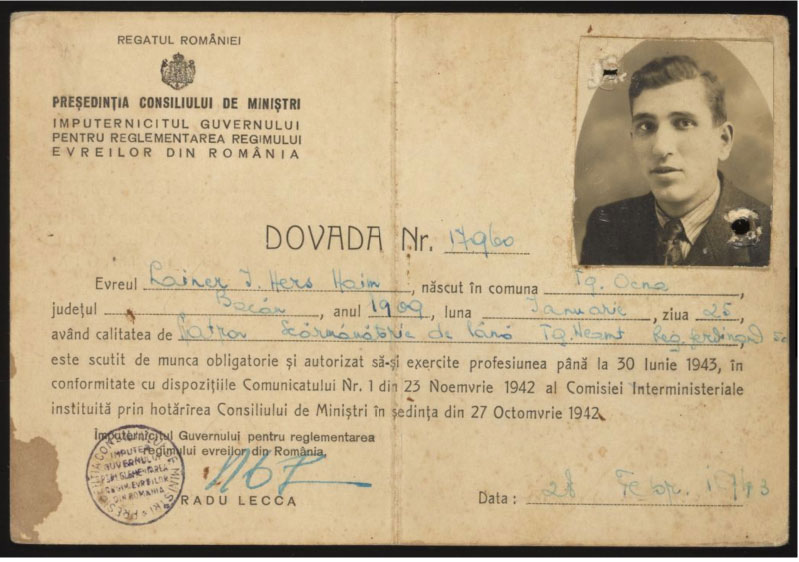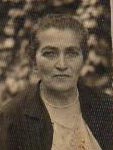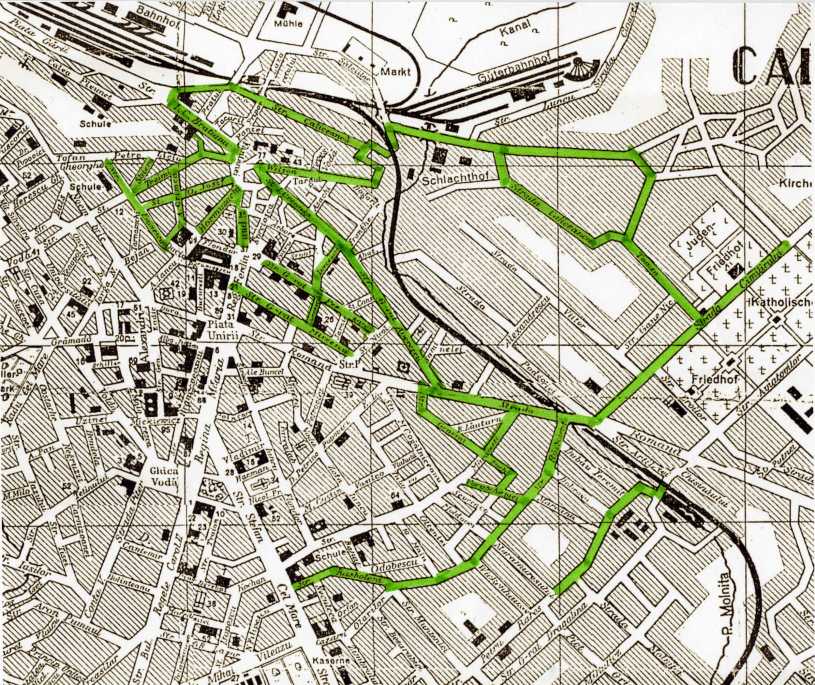On October 11, 1941 the Jews in Czernowitz reported to the city ghetto, from which they would be evacuated to the camps forming in Transnistria. No signs were posted – they are notified orally that they must report to the ghetto, and that anyone found in their home after that time will be shot. Possessions were gathered and by 7am on the 12th the Jewish population was well on their way. A 3-meter high wooden fence surrrounded the established area, a four-block radius, where 30,000 people came to be in residence as they waited for their evacuation orders.

In 1942, the Ghetto was officially dissolved. A relatively large number of people received authorizations from Mayor Traian Popovici to remain in the city. He authorized about 4000 skilled workers to remain, and those who were lucky were called “Traian’s Jews”. Unfortunately, when Popovici fell out of favor owing to his sympathetic attitude towards Jewish residents of the city, Governor Calotescu issued a decree, summoning all permit holders to have them reviewed by a military commission. Permitted Jewish residents were hunted down for deportation. The remaining residents moved frequently, hid, and bribed personnel, anything to stay — as word had come back by this time what awaited in Transnistria. When they could, they moved in with family or friends in the allowed areas of the city was the only solution as they awaited more deportations.


I discovered one of these apartments as I researched my Great-Uncle Abraham Schmatnic. Born in 1910 in Czernowitz, his wartime address is listed in Yad Vashem as Str. Dionisie Bejan, Nr. 10. In Austrian times the name of the street was Pardinigasse. According to the Urban Image Database , the eastern side of the Ringplatz was known as Pardini Höhe (Pardini height) until WW2. It got its name from the then well known publishing house and bookshop Pardini. Between WW1 and WW2 the name of the street changed to Strada Dionisie Bejan. The name of the street in the Soviet period became Klara Zetkin Street. The street in present-day Chernivtsi is located in the alleyways west of the Philharmonic Square, and I believe it is now named Troyandova Street: Трояндова вулиця, 10

Berti Glaubach, a wartime resident of Czernowitz, noted that, “In 1942 most of the better apartments of the Jewish population had been requisitioned by Romanian officials for their families. All those Jews moved to that part of the town where their families lived and shared their apartment. Also in that part of the town where a lot of empty apartments left over by those deported to Transnistria in 1941. Padinigasse was part of the Jewish Quarter where Jews were allowed to move. The closed Ghetto was dissolved in November 1941 after the main part of deportations took place, and there were no physical barriers between the Jewish quarter and the main part of the town. The restrictions were circulating only between 10.00 and 13.00 and wearing the yellow David star.”
Residents of #10 Dionisio Bejan
On the Yad Vashem website Testimonies are cross-referenced with multiple options. I’ve often become lost for hours following connections and maiden names, marriages and misspellings that are all great research clues. You can also cross reference by address. I was able to easily find all entries with the wartime address Strada #10 Dionisie Bejan.
Most of these names were not instantly recognizable to me but digging a little deeper, I found that most of them were related to my family.
However, few residents seem to have no connection to my family other than friendship, or chance. One is Emanuel Halpern. Emanuel was 78 years old in 1943, when he appeared on the List of Jewish Pensioners and Jews above the age of 70 from Cernauti. Born in 1865, he registered with the Central Bureau of the Jewish Center in Romania in 1943. A younger gentleman named Hers Haim was sent to forced labor in Targu Neamt listing this as his address. In the USHMM Jewish Community of Targu Neamt Collection, I was able to locate his ID card. It shows his birthdate as January 25, 1909, which would make him 34 years old at that time. The card verifies that he is exempted from compulsory work for a period of time.

Emanuel Landwehr was another resident. The Landwehrs were a very distinguished Czernowitz family, related to my family by marriage. My great aunt Jenny Schmatnic married Herman Landwehr, probably in the 1930s—as I have been told by a Landwehr relative, who was the same age as the younger Berthold and Arthur Landwehr. Jenny and Herman, and their son Ossy were all deported to Transnistria, and were sadly separated during the journey, and though Jenny and Ossy survived the war in Iampol, Transnistria, Herman did not. Emanuel Landwehr was born in 1905 to father Isak. In 1927 he was an Electrician, living at #20 Jancu Zota in the inner city. In 1942 when he was at #10 Dionisio Bejan he would have been 37 years old. Emanuel appears to have escaped deportation.
Also in residence was my great aunt Lotti Schmatnik Sand. In 1942 Lotti resided at two different addresses in Czernowitz: In August at Avram Iancu #6, and in November at Strada General Mircescu #22. In 1943 she was in residence at Dionisie Bejan. Lotti was deported to Transnistria —apparently on several different dates in 1943 and 1944. (Confusingly – 11/18/1943 and also 12/13/43 and 1/4/44). Andrey Shmatnik, a cousin born in Czernowitz, recalls meeting her around 1970, so we know she survived the war.

Rosa Engler Schmatnik was born in 1880, she is my great-grandmother. She was 71 in 1942 and appeared on a list of Jews not intended for deportation living at this address.
My great aunt Rebecca or Rifka Schmatnik Zimbler was also a resident, along with her husband Moritz Zimbler and his mother Rosa. Rosa was born in 1871 and was also a Jewish Pensioner. Moritz married Rebecca Schmatnik in 1931. Rebecca died in 1945.
Abraham Schmatnic changed his name to Engler (his mother’s maiden name) and emigrated to Venezuela. His son Dr. Jonny Engler tracked me down eleven years ago—a great surprise! Jonny contacting me inspired me to begin my in-depth research of my ancestors.


https://www.ushmm.org/remember/holocaust-reflections-testimonies/behind-every-name-a-story/erna-rubin
LikeLiked by 1 person
Hi Iris,
The first paragraph has some data that although not relevant to the rest of your family research should be corrected.
The closed Ghetto was changed to an open one after some 25 days of its opening in early November 1941, after the deportations to Transnistria.
From a population of 55.000 Jews, some 25.500 thousand remained in Czernowitz, mainly because of Traian Popovici’s interventions and activity, 19.000 authorizations signed by the military governor and another 6.500 by Popovici himself, although he had no authority to do so. In July 1942, after Traian was dismissed from his post of Major, those 6.500 were hunted down by the police on two succeeding Sundays and most of them deported in that second lot.
Was nice and interesting to read your research.
Berti.
LikeLike